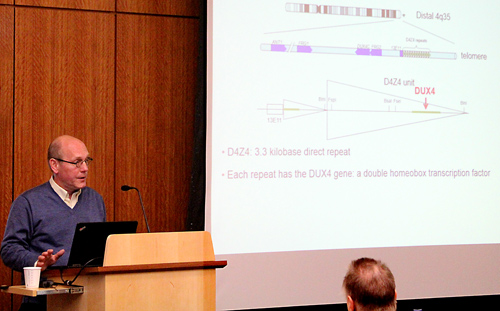Posted by Gregory J Block MSc PhD on Feb 4, 2015

The goal of the large grant was to give Dr. Tapscott the freedom to pursue exciting new ideas, expand collaborative efforts, and enhance the FSHD program in his lab.
Our funding has helped the Tapscott lab achieve several major milestones that have been reported in at least 10 scientific publications. In addition, Dr. Tapscott has led multiple individual and collaborative grants awarded by the National Institutes of Health, including the latest $6.3 million Paul D. Wellstone Muscular Dystrophy grant.
Of note, there were experiments carried out in Dr. Tapscott’s lab that have set the gold standard in the field.
- The team initially described how the DUX4 transcription factor changes the genetic program of muscle cells, and thus identified the current biomarkers that are now commonly used. The studies have been validated by other labs throughout the world.
- The lab purified and classified reliable antibodies that can be used to detect DUX4. These antibodies have now been used by investigators in Seattle and all over the world as a tool for detecting and quantifying DUX4.
- The lab was involved in the seminal discovery of the gene that causes FSHD2 and the observation that FSHD1 patients with the FSHD2 genetic mutation have a more severe form of the disease.
Ultimately, the data generated from these studies has supported the initial hypothesis that DUX4 plays a central role in the pathology of FSHD , and has led the field to a consensus on the root cause of FSHD.
With powerful data and tools in hand, Dr. Tapscott has also reached out beyond his own lab to develop academic and industry collaborations to search for lead compounds to treat the disease. Over the last two years, millions of compounds have been screened and further studies are being conducted to advance the development of potential therapies.
Most recently, our scientific advisory board has approved funding for the final year of the grant. In the latest progress report, Dr. Tapscott outlined his plan for advancing his current research program and making additional resources available to the FSHD research community.
References
1: Young JM, Whiddon JL, Yao Z, Kasinathan B, Snider L, Geng LN, Balog J, TawilR, van der Maarel SM, Tapscott SJ. DUX4 binding to retroelements creates promoters that are active in FSHD muscle and testis. PLoS Genet. 2013 Nov;9(11):e1003947. doi: 10.1371/journal.pgen.1003947. Epub 2013 Nov 21. PubMed PMID: 24278031; PubMed Central PMCID: PMC3836709.
2: Yao Z, Snider L, Balog J, Lemmers RJ, Van Der Maarel SM, Tawil R, Tapscott SJ. DUX4-induced gene expression is the major molecular signature in FSHD skeletal muscle. Hum Mol Genet. 2014 Oct 15;23(20):5342-52. doi: 10.1093/hmg/ddu251. Epub 2014 May 26. PubMed PMID: 24861551; PubMed Central PMCID: PMC4168822.
3: Lemmers RJ, Goeman JJ, van der Vliet PJ, van Nieuwenhuizen MP, Balog J, Vos-Versteeg M, Camano P, Ramos Arroyo MA, Jerico I, Rogers MT, Miller DG, Upadhyaya M, Verschuuren JJ, Lopez de Munain Arregui A, van Engelen BG, Padberg GW, Sacconi S, Tawil R, Tapscott SJ, Bakker B, van der Maarel SM. Inter-individual differences in CpG methylation at D4Z4 correlate with clinical variability in FSHD1 and FSHD2. Hum Mol Genet. 2014 Sep 25. pii: ddu486. [Epub ahead of print] PubMed PMID: 25256356.
4: Tawil R, van der Maarel SM, Tapscott SJ. Facioscapulohumeral dystrophy: the path to consensus on pathophysiology. Skelet Muscle. 2014 Jun 10;4:12. doi: 10.1186/2044-5040-4-12. eCollection 2014. Review. PubMed PMID: 24940479; PubMed Central PMCID: PMC4060068.
5: Sacconi S, Lemmers RJ, Balog J, van der Vliet PJ, Lahaut P, van Nieuwenhuizen MP, Straasheijm KR, Debipersad RD, Vos-Versteeg M, Salviati L, Casarin A, Pegoraro E, Tawil R, Bakker E, Tapscott SJ, Desnuelle C, van der Maarel SM. The FSHD2 gene SMCHD1 is a modifier of disease severity in families affected by FSHD1. Am J Hum Genet. 2013 Oct 3;93(4):744-51. doi: 10.1016/j.ajhg.2013.08.004. Epub 2013 Sep 26. PubMed PMID: 24075187; PubMed Central PMCID: PMC3791262.
6: Krom YD, Thijssen PE, Young JM, den Hamer B, Balog J, Yao Z, Maves L, Snider L, Knopp P, Zammit PS, Rijkers T, van Engelen BG, Padberg GW, Frants RR, Tawil R, Tapscott SJ, van der Maarel SM. Intrinsic epigenetic regulation of the D4Z4 macrosatellite repeat in a transgenic mouse model for FSHD. PLoS Genet. 2013 Apr;9(4):e1003415. doi:10.1371/journal.pgen.1003415. Epub 2013 Apr 4. PubMed PMID: 23593020; PubMed Central PMCID: PMC3616921.
7: Lemmers RJ, Tawil R, Petek LM, Balog J, Block GJ, Santen GW, Amell AM, van der Vliet PJ, Almomani R, Straasheijm KR, Krom YD, Klooster R, Sun Y, den Dunnen JT, Helmer Q, Donlin-Smith CM, Padberg GW, van Engelen BG, de Greef JC, Aartsma-Rus AM, Frants RR, de Visser M, Desnuelle C, Sacconi S, Filippova GN, Bakker B, Bamshad MJ, Tapscott SJ, Miller DG, van der Maarel SM. Digenic inheritance of an SMCHD1 mutation and an FSHD-permissive D4Z4 allele causes facioscapulohumeral muscular dystrophy type 2. Nat Genet. 2012 Dec;44(12):1370-4. doi: 10.1038/ng.2454. Epub 2012 Nov 11. PubMed PMID: 23143600; PubMed Central PMCID: PMC3671095.
8: van der Maarel SM, Miller DG, Tawil R, Filippova GN, Tapscott SJ. Facioscapulohumeral muscular dystrophy: consequences of chromatin relaxation. Curr Opin Neurol. 2012 Oct;25(5):614-20. doi: 10.1097/WCO.0b013e328357f22d. Review. PubMed PMID: 22892954; PubMed Central PMCID: PMC3653067.
9: Krom YD, Dumonceaux J, Mamchaoui K, den Hamer B, Mariot V, Negroni E, Geng LN, Martin N, Tawil R, Tapscott SJ, van Engelen BG, Mouly V, Butler-Browne GS, van der Maarel SM. Generation of isogenic D4Z4 contracted and noncontracted immortal muscle cell clones from a mosaic patient: a cellular model for FSHD. Am J Pathol. 2012 Oct;181(4):1387-401. doi: 0.1016/j.ajpath.2012.07.007. Epub 2012 Aug 4. PubMed PMID: 22871573; PubMed Central PMCID: PMC3463638.
10: Geng LN, Yao Z, Snider L, Fong AP, Cech JN, Young JM, van der Maarel SM, Ruzzo WL, Gentleman RC, Tawil R, Tapscott SJ. DUX4 activates germline genes, retroelements, and immune mediators: implications for facioscapulohumeral dystrophy. Dev Cell. 2012 Jan 17;22(1):38-51. doi: 10.1016/j.devcel.2011.11.013. Epub 2011 Dec 29. PubMed PMID: 22209328; PubMed Central PMCID: PMC3264808.





Connect with us on social media